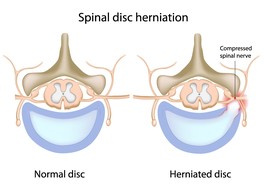

What is a herniated disc?
The discs are located between the bones of your spine (vertebrae). They are spongy and act as shock absorbers to your spinal joints. The gel-like center of the disc is surrounded by layers of fibrous walls that give the disc strength. A herniated disc, also known as a ruptured or slipped disc, is when the outer layers of these walls break or tear, possibly allowing some of the gel to leak out and into the area of the nerves.

Symptoms of a herniated disc depend on what structures are involved. If no nerves are involved you may have only back pain, achiness or stiffness. If a nerve is irritated or inflamed, you may experience leg pain, numbness, tingling or burning. If a nerve is compressed or pinched you may experience leg weakness.
Common Causes
Disc herniation is commonly the result of wear and tear of the spinal joint (including the disc) that happens with the natural aging process referred to as spinal degeneration. As the disc ages it becomes more dehydrated, less flexible and more susceptible to tearing or herniating. Injury from a trauma can also cause a disc herniation.
Examination and Diagnosis
To receive a diagnosis, a qualified musculoskeletal expert will first take a medical history and conduct a physical exam. X-ray or MRI scanning may be required.
If you experience bowel or bladder changes and/or saddle (groin) numbness, please contact your physician.
Treatment Options
Copyright © www.orthopaedics.win Bone Health All Rights Reserved